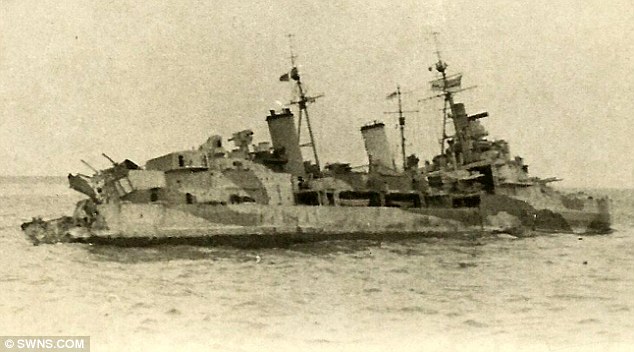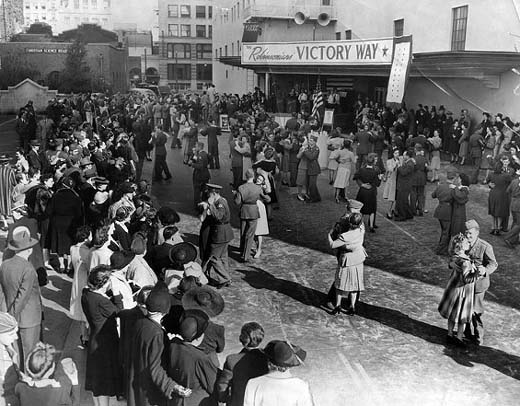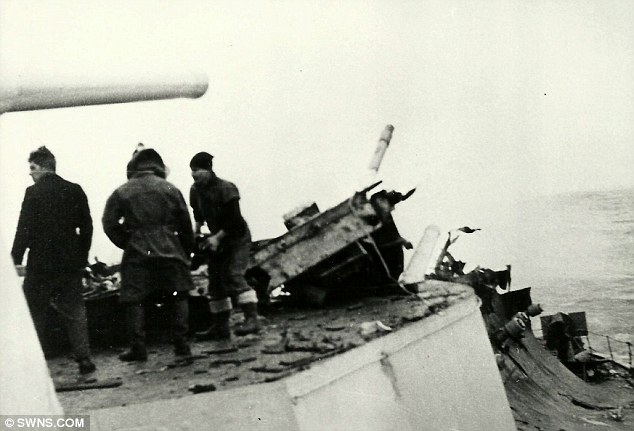Air Operations, Europe
BOMBER COMMANDIn a huge mine-laying operation 96 aircraft are involved from Germany to Brittany. 2 Manchesters are lost. 11 aircraft make leaflet flights to France with no losses.
[Air Operations, Mediterranean
British aircraft carry out overnight raids on the islands of Rhodes and Leros and, in Greece, on the Piraeus area and the outskirts of Athens.
[Barents Sea
The cruiser HMS Edinburgh, already damaged by U-456 on 30 April, is further damaged by German destroyers under tow to Kola Inlet. 43 more of her men are lost in this action. After this attack she is scuttled by the British destroyer Foresight.
|
|
HMS Edinburgh Sinks |
 |
Australia, Home Front
The area of Townsville, in north Queensland, is put on invasion alert.
[Battle of the Atlantic
U-402 torpedoes and sinks the US yacht Cythera (PY-26) off the coast of North Carolina. 66 men are lost; 2 survivors are rescued by the U-boat and taken back to Germany as POWs.
[Battle of the Coral Sea
The buildup to the Battle of the Coral Sea begins. The principal aim of the Japanese plans is the capture of Port Moresby. The Japanese forces are divided into 5 groups to accomplish this and other subsidiary tasks. These forces include the large carriers Zuikaku and Shokaku under the command of Vice-Adm Takeo Takagi which are to provide overall cover.
A second group with the small carrier Shoho and 4 heavy cruisers, Rear-Adm Amitomo Goto, is to help first with close support for the landings on Tulagi, to establish a seaplane base there, and then with the main operations. Vice-Adm Nariyoshi Inouye commanding at Rabaul, from where the main invasion force is to set out, is in command.
Largely because of American ability to read the Japanese codes, Adm Nimitz is able to order a concentration of Allied task forces to oppose the Japanese who in turn believe that there can be at most one enemy carrier in the area. The small Australian garrison's withdrawal from Tulagi is designed to encourage the Japanese attacks by feigning weakness. The officer commanding the naval squadron, Task Force 17, patrolling the Coral Sea, Rear-Adm Frank J. Fletcher, immediately heads for Tulagi with the carriers Yorktown (CV-5) and Lexington (CV-2) and supporting forces. The other Allied ships come from 2 other task forces: Task Force 11, under Rear-Adm Aubrey Fitch, with the carrier USS Lexington and Task Force 44, under Rear-Adm John G. Crace, with Australian and American cruisers. At first only Task Force 17 is in operation.
[Burma
Monywa is attacked by 3 brigades (63rd, 13th and 1st Brigades) of the Burmese I Corps but are driven back by the Japanese who had just captured the place. The attacking troops fall back in disorder while the rest of the Burma forces fall back to Shwegyin.
[Norwegian Sea
The Polish submarine Jastrzeb is mistakenly attacked by the Norwegian destroyer St Albans and the British minesweeper Seagull off northern Norway with the loss of 5 on board. After the mistake is realized, St Albans and Seagull rescues the survivors. The minesweeper then scuttles the badly damaged submarine.
[Pacific
- The US submarine Drum (SS-228) sinks the seaplane carrier Mizuho (10,930t) off southeastern Honshu.
- The US submarine Trout (SS-202) torpedoes and sinks the Japanese merchant cargo ship Uzan Maru (5015t) off the southeast coast of Honshu.
Philippines
MINDANAOThe 73rd Infantry (PA), reinforced with stragglers of the defeated 61st, attempts to stall the enemy advancing north along Route 1. Unable to hold the southwest corner of Lake Lanao, the 73rd withdraws north, establishes a line from Lake Lanao across Route 1, and delays the enemy briefly. The Japanese detachment form Cotabato continues to move east toward Kabacan. Brig-Gen Joseph P. Vachon, the CG of the Cotabato-Davao defense sector, places all available forces at Kabacan. The Digos defense force, ordered to withdraw to Kabacan, starts to move that way during the night. The Cagayan defense sector is alerted as an enemy convoy heading toward Macajalar Bay is sighted.
CORREGIDORA Japanese 240-mm AP shell blows up a powder magazine on Corregidor, hurling super-heavy mortars into the air. 3,600 shells fall on the island in 5 hours.
[Solomon Islands
In the southern part of the archipelago, near Guadalcanal, a Japanese convoy is preparing to land troops on the small island of Tulagi. The small Australian garrison there destroys all of the island's installations and leaves for the New Hebrides.
[United States, Policy
Lend-Lease is extended to Iran and Iraq.
[ War Bond Sales Celebration |
 |

